HOME >> METRO SHANGHAI
Going green and conserving cash
By Fang Shaoqing Source:Global Times Published: 2015-6-17 18:13:01
Energy saving in city buildings has economic advantages
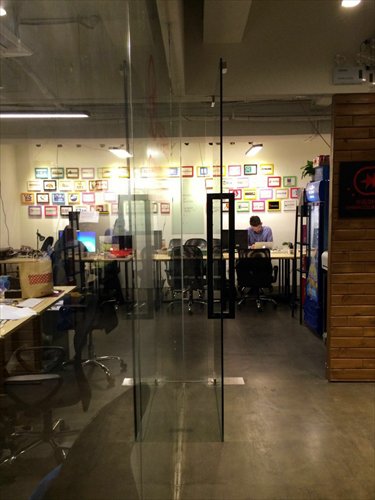
The former Donghai Square factory now offers work spaces for a variety of start-up teams. Photo: Courtesy of Bob Zheng
The Seesaw Coffee is a warm welcoming coffee bar on the ground floor of the Central Pod (Possibility of Design) headquarters. This creative office and commercial space near Jing'an Temple is the Jing'an Design Center and the Seesaw Coffee is no ordinary coffee bar. The minimalistic décor accentuates the fact that the tables and chairs here are all made from recycled wood.The spiral staircases lead to offices, meeting rooms and work spaces and the loft style building has a pleasant open and airy feeling to it, perhaps because it is the result of two once abandoned factories being combined for this venture. French architect Thomas Austerveil has imbued some of the latest and most exciting green philosophies and technologies in this building.
"The CO2 emissions equivalent of building the actual structure including the concrete, columns, slabs and foundations are from 40 years of heating, cooling, air-conditioning and lighting for this building," Austerveil told the Global Times, "Reusing an old building is actually the greenest thing you can do."
A major part of this makeover project was the atrium. The original atrium space of the two old buildings that form the Design Center was very dark - the original buildings were used as factories and the ground floors were largely used as car and bike parks. By replacing the old roofs with glass suddenly the building took on a different feel and even in winter gives the inside an attractive sunny disposition.
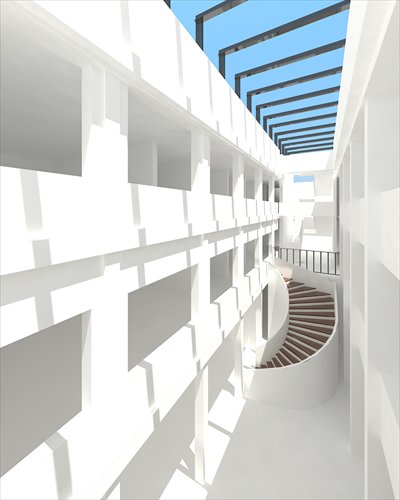
The atrium of the Jing'an Design Center Photo: Courtesy of Thomas Austerveil
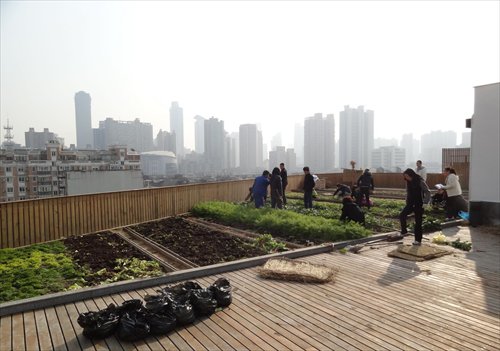
A garden on the roof supplies fruit and vegetables along with insulation. Photo: Courtesy of Thomas Austerveil
Computer simulations
To make this the most comfortable for the inhabitants, the design team collated Shanghai climate data and calculated the best temperatures for people to experience during the year. Before they started actual work they completed computer simulations to ensure the atrium would be able to offer the premium temperatures. And it works. In winter when the skylights are closed the sun still helps warm the inside - when the temperature outside is just 4 or 5 degrees, inside it can reach 18 degrees. In summer, the skylights can be opened to let natural breezes cool the interior.
Older buildings can be adapted and made user-friendly. When a building can use natural lighting, there can be a 30 percent saving in electricity.
Austerveil said other minor changes meant that special air conditioner casings were built to work as solar shades and avoid the intrusion of the southern summer sunlight that heats the city from April to September and a great deal of air-conditioning use has been avoided.
The team also took to the roof of the building to create a garden that grows fruit and vegetables throughout the year - and acts as a natural insulation barrier.
The Jing'an Design Center is a good example of the modern work spaces sought by start-up and incubator companies. Another which adopted a similar approach building is the former Donghai Square factory which is now offices for a variety of start-up teams in Yuyuan Road, Jing'an district. This building was retrofitted by Bob Zheng and his team in 2014. When Zheng found the place he and friends decided it would suit them and they rented it and renovated it themselves.
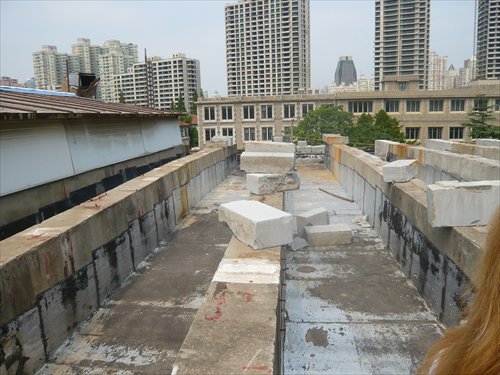
A picture of the factories before they being redesigned Photo: Courtesy of Thomas Austerveil
Staying connected
The people in the offices here are working on different projects and for different businesses but they stay connected. Incubator companies can offer teams help and advice, Zheng said. The young entrepreneurs involved were happy with this open cooperative environment that links a network of professionals for a low cost, breaking through the distance and trust problems of the Internet, he said. The start-up teams range in size from two to 10 staff.
"The people who work here enjoy discussing their business plans and new ventures see this as good workplace," Zheng told the Global Times.
Many building owners who want to make their premises greener and more economical don't know where to start when they look for solutions that could let them produce their own energy or improve insulation, air-conditioning, lighting, or indoor air quality, according to Alex Shoer, the CEO and co-founder of Seeder Clean Energy, a Shanghai-based company that matches commercial buildings to energy saving technology and the financing needed for them.
"Foreign services and technologies are now entering China, but local building owners don't have access to them, so there's a big disconnect," Shoer told the Global Times. "At Seeder, we have strong ties to technology companies in the US and Europe and we're seeing great results when we match local building owners with these energy solutions."
Shoer started Seeder over two years ago and has introduced more than 50 building owners to service and technology companies so far. Seventeen of these introductions have been successful matches and resulted in full-scale projects.
With more and more local and multinational corporations in China looking to save money on energy, Seeder has been trying to match these companies with solar energy providers such as UGE International and capital sources like Blue Sky Energy Efficiency.
UGE and Blue Sky can provide clients with energy saving solutions through Power Purchase Agreements (PPA), a financing structure widely used in the US. Their first successful PPA project in China was matched by Seeder and involved a 248-kilowatt rooftop project on a logistics center in Tongzhou, Beijing.
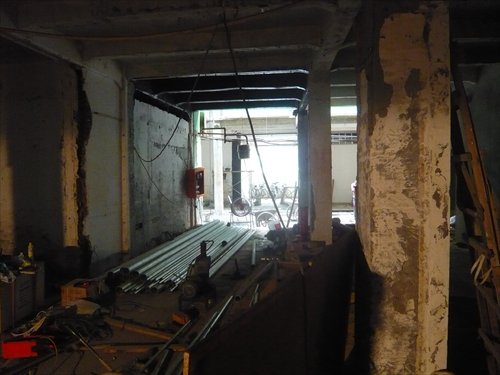
A picture of the factories before they being redesigned Photo: Courtesy of Thomas Austerveil
A real win-win
While many are enthusiastically involved with shares in China's stock markets, energy saving projects have yet to prove popular with investors. "Building owners only have to pay a fraction of the total cost and the investor can finance the rest of the project if they access energy efficient solutions," said Shoer. "Once you understand which technology or service to connect the building with, then you just need the financing to reduce the upfront costs. The financiers get paid back through the energy saved or generated. It's really a win-win," he said.
Seeder has been identifying projects that have quick payback periods of three to five years in the hope of attracting more banks or private investors to the energy financing market.
While the Chinese government has programs that support energy retrofitting for buildings, there's often a disconnect between government subsidies and these buildings.
"Even Chinese developers and owners who know the rules and regulations still don't know how to get access to the subsidies," said Shoer. He sees this as a big opportunity to bring the two parties together, using online technology to streamline the process.
Changning district government's retrofit project is an example of how local governments can support a community's sustainability.
"Most buildings in Changning district were built 15 to 20 years ago. One third of the buildings were built before 2000," said Shoer. "These older buildings lack energy-saving features and often have insulation problems. But the local government has found a way to improve the situation."
In 2010, Changning applied to the World Bank for a loan to retrofit Changning's old buildings and the loan was approved in June, 2013. According to an official from the Low Carbon Department of the Changning district government, along with a low interest loan, the World Bank granted the retrofit project an initial 5 million yuan ($805,500) for research and assessment to see whether the buildings were more energy efficient after retrofit, which technologies were the best and which policies should be adopted to continue the project. The official said the Changning government has also been discussing funding with some medium and small-sized banks.
The Changning government's retrofitting project was based on an Energy Service Company (ESCO) model, which in China is more often known as an Energy Management Company (EMC) model where a company provides energy solutions as well as financing to help clients reduce energy costs.
"In the US it is common practice to do energy management contracting projects with government buildings," Peter Corne, an environmentalist and managing partner of Dorsey and Whitney LLP, told the Global Times. The standard model involved an energy service company and contracts with the government and a bank.
China has many energy service companies but it's not easy to finance them. "In the US, the companies get financed because the banks trust the model. Also, they trust the measurement of the energy saving," said Corne. It's hard for China's energy service companies which are mostly small private companies to get loans.
"First, the banks don't have the expertise to understand the industry. They don't have experienced people who understand the risks," he said, "Also, banks don't trust the baseline for measurement and verification of energy saving because it is much more complicated in green buildings."
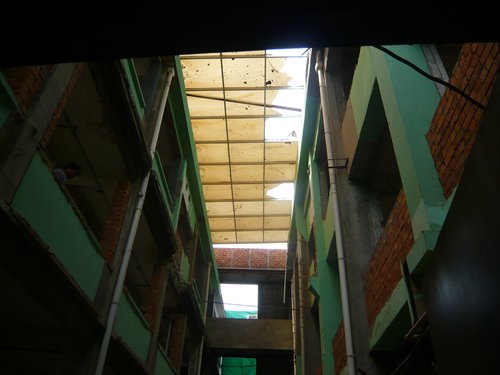
A picture of the factories before they being redesigned Photo: Courtesy of Thomas Austerveil
Willing to invest
Other investors are loath to finance new technologies because they want quick return. However, many corporate investors were used to this process and were willing to invest in energy saving products or in research and development, Corne said.
He said in China it had been a major challenge for energy sustainability to get the technology commercialized. "The more energy-saving technologies are applied, the less electricity is used from the grid. People get their money back over time, which usually takes 10 years."
But at present, electricity in China is very cheap, making it difficult for new technology to be an attractive investment. Corne has been helping a company to fund a project to install solar panels - participating firms would not have to pay for the actual solar panels. "But whether the solution gets a chance depends on China's electricity price," he said.
He hopes more institutions and young people can be educated in both the technical and financial aspects to support energy efficiency solutions.
Posted in: Metro Shanghai, City Panorama